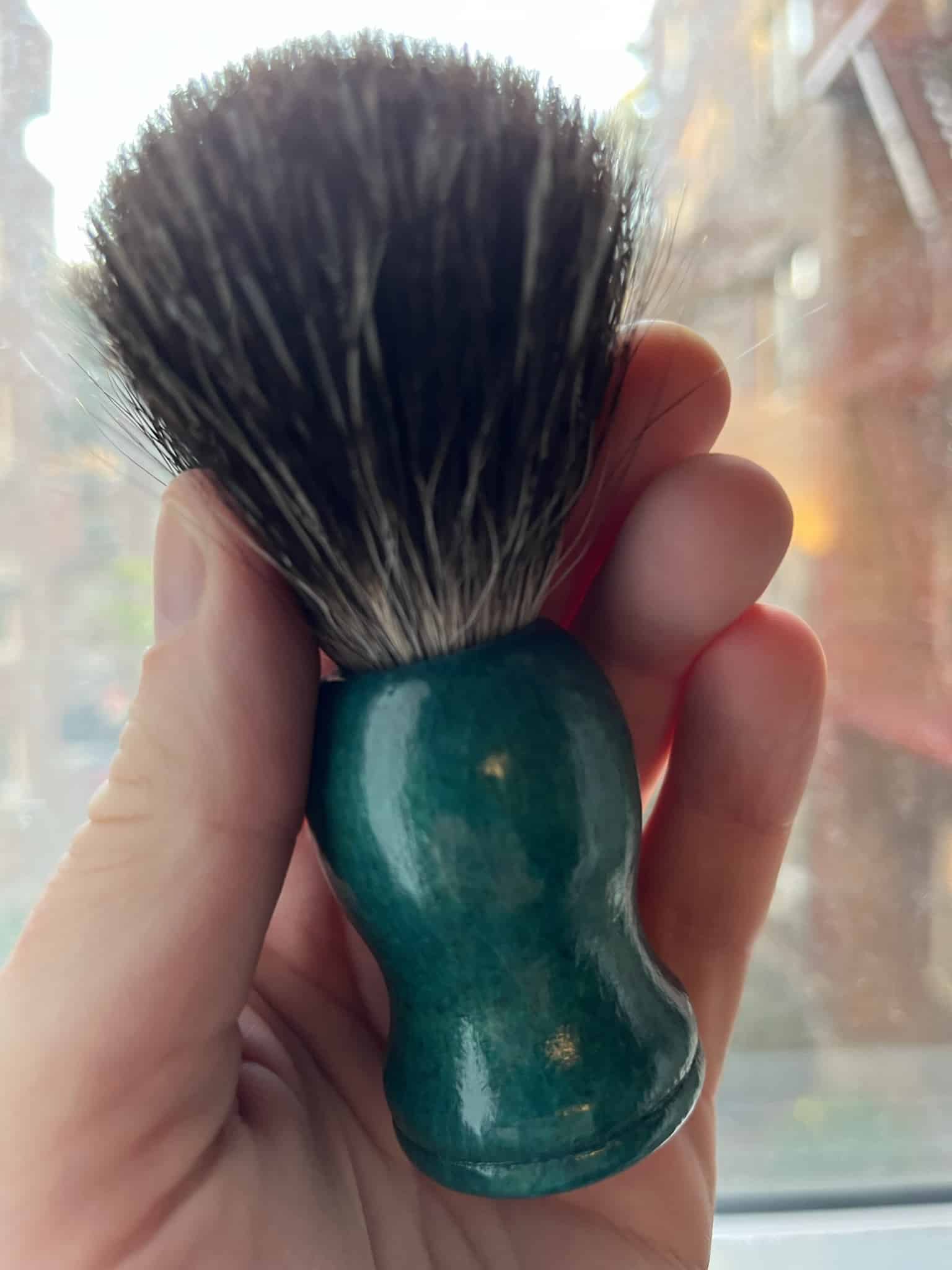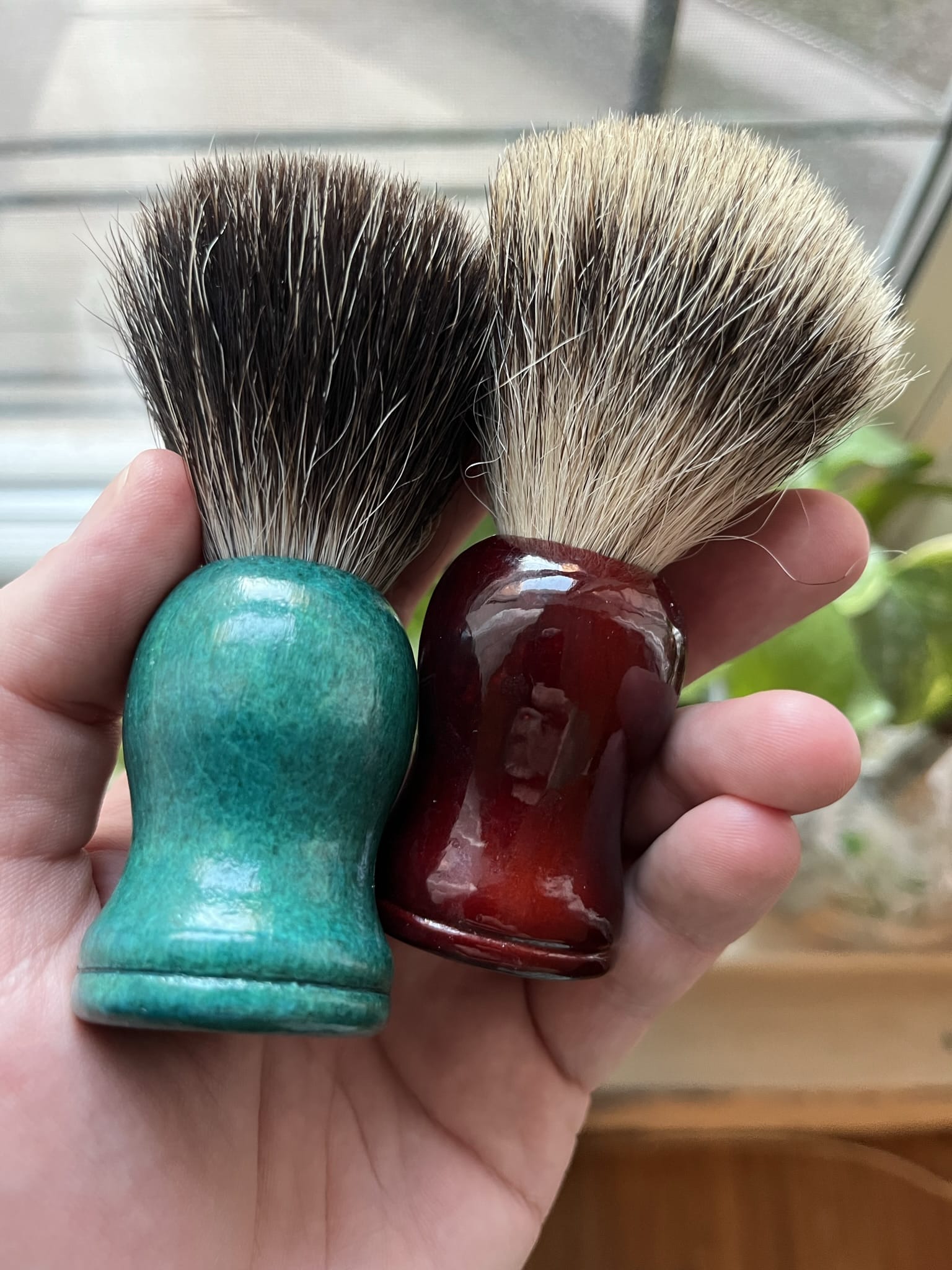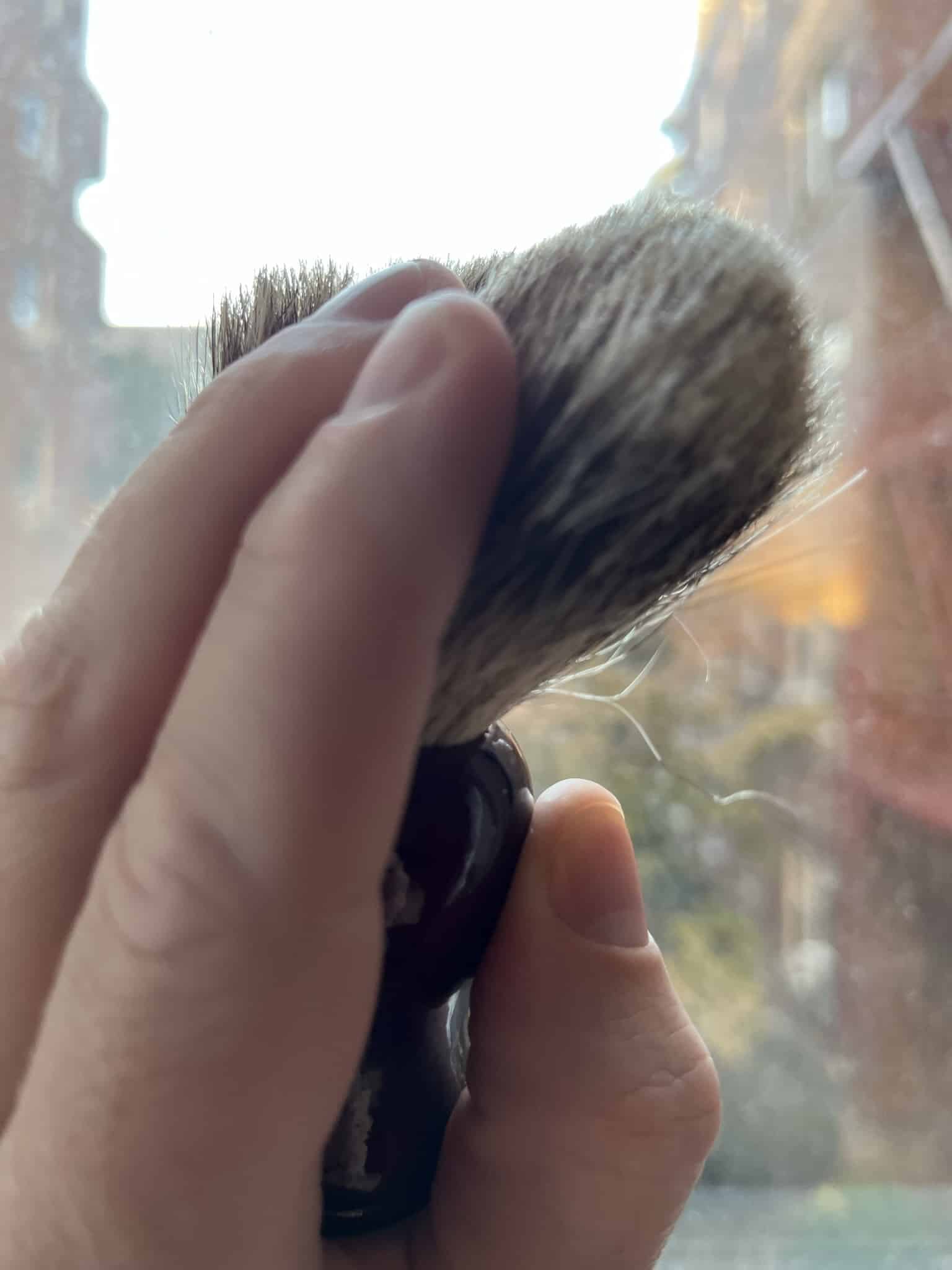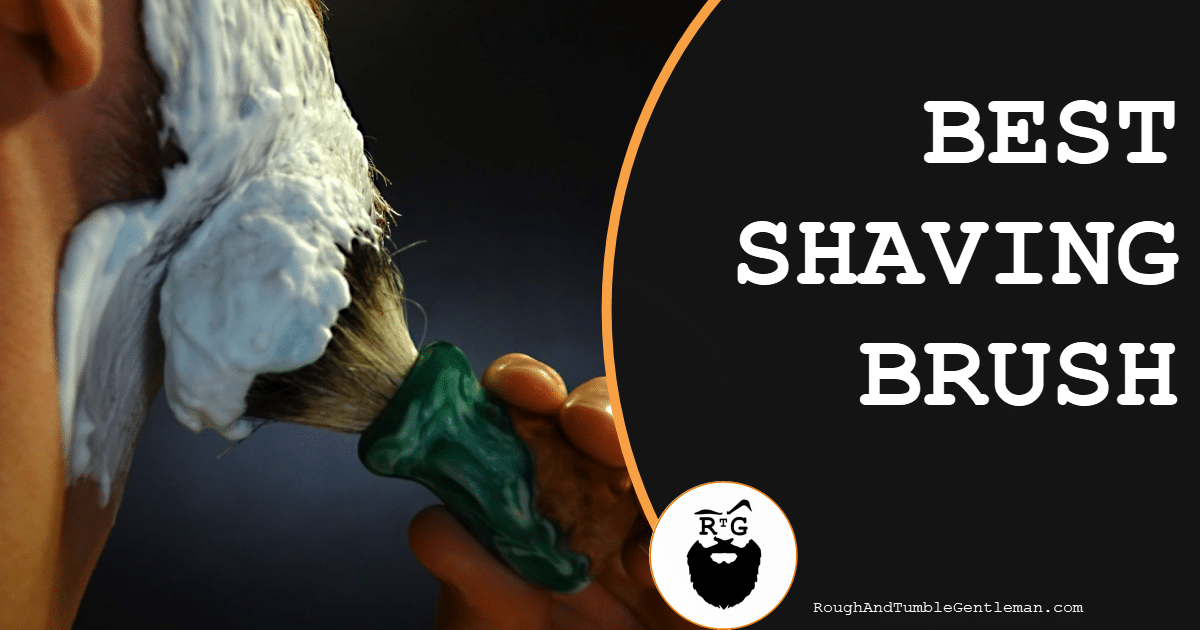When we talk about safety-razor and straight-razor shaving, most often we’re talking about razor-sharp blades which provide a fantastically close shave, but are, by their design, fantastically dangerous and deadly. Sometimes it’s nice to think about the softer, more luxurious side of things—and when it comes to wet shaving, that would be shaving soaps and the absolute best shaving brushes.
They’re somehow both delicate and sturdy, long-lasting but temporary, and of secondary importance to razors but vital nonetheless—and delightful to own and use.
So that’s why we’re excited to present you with our picks for the best shaving brush options to own and use as part of your daily shaving ritual.

This was fun to research—from gorgeous, high-end silvertip badger brushes to beginner-friendly / vegan-friendly synthetics.
Hopefully there’s something here for each of our valued readers. (we think there is)
Review Summaries—Our Picks at a Glance
Here’s a quick rundown of our top picks, to help you pinpoint your next shaving companion:
Best Synthetic Shaving Brush: From heritage brand Alexander Simpson, the Trafalgar Synthetic Shaving Brush is a wonderful example of using traditional techniques with modern materials. We find it very soft to the touch but with a firm backbone, making it a fairly balanced choice for all kinds of wet shavers.
Best Silvertip Badger Shaving Brush: The Parker Silvertip Badger Brush features real Silvertip badger hair bristles, known for their luxurious softness and prestige. We think it’s an elegant and classy choice that could suit guys with sensitive skin.
Best Badger Shaving Brush: Edwin Jagger’s Best Badger Shaving Brush with Drip Stand is made with “best”-grade badger hair, which is not quite as soft as Silvertip or synthetic bristles. That’s not a bad thing! We think you may like it a lot if you want a shaving brush that offers a little more exfoliation or that’ll do quick work of lathering up very firm soaps.
Best Premium Brush: The extra-large MUHLE Classic Black X-Large Silvertip Fiber Shaving Brush is our top choice if you want something that’ll feel a little fancier. We think it’s very soft thanks to the trademark synthetic bristles, and its larger size could help you cover your entire face with lather in seconds.
Best Boar Shaving Brush: If you don’t mind spending some time breaking in your brush, the Semogue Excelsior 830 Shaving Brush is our favorite boar bristle option thanks to its quality construction and vintage design. Boar bristles can be a little scratchy at first, but we think it’ll get surprisingly soft once you give it some love.
Best Brush for Travel: The Rockwell Synthetic Shave Brush is small yet impressive. It’s our top pick for travel because of its size, but we also really love the soft bristles which we think are a good choice for sensitive skin or newcomers to shaving.

Full Shaving Brush Reviews
And now, enjoy some detailed shaving brush reviews. These should help you understand what makes each one of these brushes so special.
Best Synthetic: Alexander Simpson Trafalgar Synthetic Shaving Brush
Don’t let the term synthetic scare you off—nowadays, many experienced wet shavers actually prefer synthetic shaving brushes, even if they don’t sound as impressive. Modern synthetic brushes can be just as soft to the touch as animal hair brushes, and they tend to dry more quickly which can be an added convenience.
And as far as synthetic brushes go, we’d argue the Trafalgar still has plenty of traditional cred. Alexander Simpson is a heritage brand that has been making shaving brushes since 1919. Even though the Alexander Simpson Trafalgar Synthetic Shaving Brush is made with modern synthetic bristles, it’s hand-crafted on the Isle of Man following the same techniques used for animal hair brushes.
As for performance, which is what you really care about, you’ll probably find that this brush is fairly soft on the skin, but can still have the firmness needed to generate a thick lather in a bowl. We find that it can create a lot of foam quickly, especially with creamier shaving soaps.
That said, we think it might be a little too firm for face lathering if you have sensitive skin since it may put too much pressure on your face. For normal or hearty skin types, though, face lathering probably doesn’t need to be off-limits, and you may find that it even offers your skin some nice exfoliation despite being a soft synthetic.
The knot has a 24 mm diameter, which we find is a very good size for most face sizes, with a good balance of quick coverage and some precision. That said, guys with large faces or that shave their heads may prefer the larger but otherwise very similar T3 model, instead.
Finally, we enjoy the look of the creamy faux ivory handle, and we find that its shape is very comfortable to hold.
Best Silvertip Badger Shaving Brush: Parker Silvertip Badger Brush
Silvertip badger hair is considered the most premium material you can find for a shaving brush. If you want the best of the best, that’s the material to look for, and we think Parker knocked it out of the park with their Parker Silver Badger Brush. It’s an elegant-looking brush with a vintage-looking faux horn handle. It has a nice heft, which contributes to its luxurious feel.
Silvertip hair is collected from around the neck of the badger, so most wet shavers consider it the softest bristle. We think you may like it if you have sensitive skin since it can offer a very gentle pre-shave experience.
This brush has a 22 mm knot, which we think is about ideal—not too large or too small for the average guy. In our opinion, the bristles are packed tightly enough to have medium firmness, which you may find is enough for easy bowl lathering without compromising the brush’s give and gentleness when you apply the lather to your face. We like it just as much for face lathering as we do for bowl lathering!
When it first arrives, you may find that it smells a little like… well, badger, but a few washes will probably sort it out.
Another thing we really like is that this brush comes with a matching stand. It holds the brush upside down, which is meant to help drain any water for faster drying. That kind of useful extra accessory makes us feel like we’re buying a premium product.
Pair it with a great shaving soap for sensitive skin, and we think you’ll enjoy a gentle, pleasant shave.
Best Badger Shaving Brush: Edwin Jagger Best Badger Shaving Brush with Drip Stand
Next, we have a “best badger” shaving brush. “Best Badger” is actually a term for classifying the quality of badger hair! So in a way, this is technically the best badger shaving brush—at least, in our opinion!
The Edwin Jagger Best Badger Shaving Brush with Drip Stand is not quite as soft or luxurious as Silvertip badger hair, but it’s still considered to be of excellent quality. That’s even more true when the shaving brush comes from a reputable brand like Edwin Jagger, which also happens to produce one of our favorite safety razors for beginners.
This brush has a 21 mm knot, which is a smidge on the smaller side, but once it’s used, we find that it splays out nicely thanks to the length of the bristles and how they’re packed. Plus, we think that also makes rinsing it out a little easier since it’s not too dense!
The best badger bristles are perhaps not as soft as our Silvertip pick from Parker, but they do the job, especially if you’re not doing a face lather. You may actually find that the touch of added “scrubbiness” makes it a better choice if you use hard shaving soap instead of a creamy one.
You may find that this brush gets softer the more you use it. It could benefit from a break-in period, although it probably won’t take as long as with a boar brush. Plus, it may smell a little at first, so consider breaking it in with a good wash or practicing your lather a few times. The smell will probably dissipate soon enough!
The imitation ebony handle is quite handsome, with a sleek charm that could add some class to your bathroom, especially when you hang it on the matching stand it comes with. It’s also available in white if that’s what you prefer.
Best Premium Brush: MÜHLE Classic Black X-Large Silvertip Fiber Shaving Brush
In our opinion, MÜHLE makes some of the most elegant wet shaving accessories and tools, and their MUHLE Classic Black X-Large Silvertip Fiber Shaving Brush is no exception. It’s a deluxe option with some of the softest bristles we’ve experienced and an aesthetically pleasing design. This might be our top pick for best shaving brush overall.
Now, don’t be confused by the name. While this brush does have “Silvertip” in its name, it’s not actually made with badger hair bristles. Silvertip Fibre is actually a MÜHLE registered trademark.
The brand developed this synthetic fiber with the purpose of mimicking the natural properties of Silvertip badger hair. Since it’s synthetic, though, we think there are some differences—you may find that it dries very quickly, for instance!
We think it’s a great example of how modern innovation can improve such traditional practices. But the name itself can be a little confusing, which is why we wanted to clear things up. A lot of guys buy this brush thinking they’re getting animal hair, and we don’t want that happening to you.
This brush comes in a few sizes, but we wanted to showcase the XL. It’s the biggest option on our list, with a 25 mm knot. If you shave both your head and face or you just find that most shaving brushes are too small, we think you might enjoy this oversized option.
Best Boar Shaving Brush: Semogue Excelsior 830 Shaving Brush
Boar may not be as premium as badger, but it’s still a bristle option that every wet shaver should be aware of. In general, boar brushes can be a little trickier to get used to, but we think the Semogue Excelsior 830 is one of the best boar shaving brushes out there.
We find that it’s enjoyable to work with, especially compared to some of the other boar brushes out there. The reason for that is probably the type of boar hair. It’s made with what Semogue characterizes as Premium grade hair, with 90% tops (meaning that the vast majority of the bristles are at a uniform, full length).
Even so, most wet shaving enthusiasts agree that boar bristle brushes can be a little tough to work with when the brush is brand new. You’ll probably need to break it in, either by using it (just don’t judge its performance during those first few lathers), or by spending some time soaking, practicing lathering, and then rubbing it to dry.
Otherwise, you may find that it doesn’t lather well, is too rough on the face, and can even shed.
Once it’s broken in, though, you might be surprised by how much softer it becomes—it could possibly even work for face lathering if your skin is hearty!
Size-wise, we think it’s pretty standard, with a 22 mm knot and a bit more loft (i.e. bristle length), which means that it’s not too firm.
There’s also something about the unique look of the handle that we really love. The transparent bottom and red top have a really cool, vintage vibe that can’t get enough of.
Best Brush for Travel: Rockwell Synthetic Shave Brush
Small but pleasant, the Rockwell Synthetic Shave Brush could be a great wet shaving travel companion! It’s a small synthetic brush, and we think Rockwell put a lot of thought into crafting it because it still has a good backbone to aid in achieving a good lather.
We’re very impressed with this brush’s softness, and we think it’d be a marvelous option for face lathering, potentially even if your skin is a little sensitive. Plus, since it’s synthetic, it doesn’t require a break-in period, so it might be an excellent choice for beginners.
Size-wise, it’s on the small side, with a 20 mm knot, but it has enough loft (i.e. length) to splay out and cover your face. That said, we do think larger brushes are usually more convenient for daily use. If you’re a fellow with a smaller face, it could be very comfortable!
We think any wet shaver might be very happy with this brush as their secondary travel brush. Synthetic brushes have a reputation for drying more quickly than animal hair brushes, which is very useful when you have to pack and leave a hotel room in a hurry.
If you pick it up as your first brush, you’ll probably want to hang on to it once you upgrade, exactly for this reason! However, since it wasn’t originally designed as a travel brush, it doesn’t come with a bag or case, so we recommend purchasing one separately.

Benefits of Using a Shaving Brush
Are you still thinking about whether you even need a shaving brush? To us, it’s pretty much a no-brainer, but here are the benefits of making the transition to using a shaving brush with proper shaving soap.
Better lather. Luxurious, creamy, protective—shaving with a well-made lather is a totally different game than using canned foam. And if you’re making the switch to a shaving soap or soap-based shaving cream, a brush is the only way to foam it up.
Exfoliation. Shaving brushes—even the softest ones—can help scrub away dead skin cells before you shave. This helps make the skin a little smoother, for a better glide with the razor, and also keeps dead skin from stuck in the hair follicle after you’ve shaved, which could help prevent ingrown hairs. This is especially true if you decide to skip the bowl and create the lather directly on your face.
Lifts hair. As you brush the lather over your skin, your shaving brush also helps to lift the hair. This makes it easier for your razor blade to cut the hair with fewer passes, giving you a closer but still gentle shave.
Vibes. Around half the fun of wet shaving comes from the vibes. It’s the epitome of old-school cool, and it can become a ritual that can make you feel put-together and centered. Using a shaving brush to create a lather is an important step in the whole wet shaving process, and since it comes right at the start, it’s also one of the most grounding parts of it.

How to Choose a Shaving Brush
We worked hard to make our reviews as helpful as possible, but if you still have some questions or you’re just curious to learn more about shaving brushes, have a look at this section! We’ll explain all of the different factors you’ll want to consider when shopping for a shaving brush, whether it’s your first or your tenth.
Select a Material—You’ve Got a Few
You might be wondering which bristle material is the best, and the answer is that it really depends. Here’s a quick rundown of the different options, although we’ll also discuss them in more detail in other sections, as we touch on other consideration factors.
Badger. Badger hair is the most common material for brush bristles. It actually comes in grades from lowest to highest: Pure, Best, Super, and Silvertip. The lower the grade, the scratchier the bristles and the more time they’ll need to get broken in, so as you can guess, Silvertip is the creme de la creme.
If you’re interested, we discuss how badger hair is sourced in some detail at the end, but suffice it to say that most vegans and vegetarians will want to avoid it.
Synthetic. Synthetic brushes are actually our favorites. Once upon a time, synthetic bristles were scratchy and awful, but the industry has come a long way with its vegan alternatives.
Today, quality synthetic brushes are actually softer than animal hair, and they also require less maintenance—they don’t need to get broken in, they absorb water easily without soaking, and they dry faster. That said, while our skin can be pretty sensitive, we know that some guys prefer a little more friction from their shaving brush.
Boar. Boar hair is considered the roughest of the bunch, so make sure to take your time breaking in your brush before you start using it. Boar hair can also smell a little funky, but breaking it in will also help reduce the smell.
With regular use, boar brushes get softer and softer, although rarely as soft as Silvertip or synthetic bristles. Because of that, they’re great for lathering up really hard soaps or for getting a more thorough exfoliation.
Horse. Horse hair shaving brushes are not very common these days. During WWI, improperly disinfected horsehair brushes led to numerous anthrax cases, so it’s no surprise that they fell out of favor. Only now are brands starting to make them again—this time, with proper disinfection.
However, when compiling brushes for this article, we didn’t find any horse brushes that we thought were worth recommending. That’s not to say they’re inherently bad—they’re about on par with best badger brushes for softness, and sourcing the hair is actually a much more animal-friendly process. We think it’s just a matter of time before someone releases a really great horse hair brush!
Check for Softness
When compiling our list, we looked for soft, comfortable shaving brushes that feel nice against the skin. By soft, we mean that the bristles themselves are soft and pleasant against the skin—closer to a feather than a scrub brush.
Overly aggressive brushes cause too much friction, which can seriously irritate the skin. Well, there are no face scratches here!
But softness also depends on the kind of material used. Modern, high-quality synthetic brushes and the higher grades of badger hair are usually softest, while lower grades and boar hair can soften up over time.
If you like the idea of your brush doing an excellent job of exfoliating your skin, it’s okay to go with a slightly more abrasive option like the best badger brush from Edwin Jagger or the boar brush from Omega.
Check for Backbone (i.e. Firmness)
Having a backbone is important in life and it’s important in your shaving brush. Backbone is the level of firmness that your brush has, or how resistant the bristles are to being bent, as you can see here:

Ordinarily, you don’t want to push your brush around like that, but we’re trying to prove a point.
The level of firmness comes from a few factors, like how tightly the bristles are packed and how far past the handles the bristles extend (this is called loft).
You want a brush with just enough backbone to put some resistance against your shaving soap, otherwise, it won’t build up a lather. At the same time, too much backbone will prevent your bristles from spreading out when you apply the lather to your face, which can be uncomfortable and less convenient.
That’s why, when compiling our list of the best shaving brushes, we focused on brushes with a good balance between firmness and give.
See If It’s Non-Shedding
One major factor that separates excellent shaving brushes from the crowd is shedding. There’s nothing worse than a shaving brush that leaves a bunch of loose hairs all over your face, thereby clogging your razor.
As far as we’re concerned, buying a non-shedding brush is non-negotiable. In some cases, an animal hair brush might shed a little at the very start, but it shouldn’t shed at all once you’ve broken it in.
Determine the Type of Soap You Want to Use
Yup, your shaving aid also matters! Hard pucks of soap need a different brush compared to creamy formulas.
Soap. Soap is a firm, hard puck, and it takes a bit of elbow grease to get it to lather. Make sure to choose a brush with a good backbone, and you may even have more success with a more abrasive brush, like boar or one of the lower badger grades.
Cream. Creamy soaps and shaving creams both lather much more easily, so you can use any kind of brush.
Decide: Face vs. Bowl Lathering
How you lather should have a big impact over which brush you choose.
Face lather. When you do a face lather, the brush is in contact with your skin for a pretty long time and there’s a lot more friction going on. Opt for a brush that’s going to be a little softer—even soft brushes will still exfoliate your skin when you face lather, and there’s going to be a lower risk of irritation.
Bow lather. If you create your lather in a bowl, your brush will only come in brief contact with your skin, so the bristle softness matters a little less. You can get away with a slightly more abrasive brush if you want to (but soft brushes will still work for bowl lathering).
Figure Out What Size Brush You Need / Want
These are the size dimensions to consider when choosing a shaving brush—consider this your chance to also learn some brush terminology!
Knot. When shaving brushes are made, the individual bristles are gathered and then tied together, which is called a knot. The size of the knot refers to the diameter of the bristles where they’re packed tightest, since the bristles flare out at the top. The larger the knot, the more bristles and therefore the larger the brush.
For most men, a 22 to 24 mm knot like in our picks from Parker and Semogue is about ideal. At that size, the bulb is large enough that you should have no problem brushing it over your face quickly, but not so large as to make a mess.
If you’re a frequent traveler or you have a small, more angular face, you might be happy with a small 20 mm knot like in our pick from Rockwell. On the other hand, guys with very broad faces or who also shave their heads often prefer larger sizes between 25 and 27 mm, like our picks from Alexander Simpson and MÜHLE.
Loft. Loft refers to the length of the bristles. The longer the loft, the more give the brush will have and the more it’ll splay out when you brush it over your face. The shorter the loft, the more firmness and backbone a brush will have.
Handle. The bigger your hands, the bigger you’ll want your shaving brush’s handle to be, although admittedly, this is probably not as important a factor as the size of the bristles.
Choose a Handle Material
If you’re observant, you might have noticed that all of our recommended shaving brushes have synthetic handles largely made of acrylic. That’s not to say that’s the only material out there—there are plenty of brushes with wood or real animal horn handles.
The reason acrylic is the favored material is pretty simple, though. Shaving brushes come in contact with a lot of water, and even wood covered in clear coating is still less durable than a synthetic material. With a wooden brush, you’d have to be careful not to let it get too wet, or water may seep in and cause trouble.
Find One That Matches Your Aesthetic
The fancier the shaving brush, the more unique its style can be. Feel free to take your personal aesthetic into account, especially if you like to keep your wet shaving accouterments on display.
We wanted to keep our list accessible, which means we mostly opted for brushes with fairly elegant style (except for our pick from Semogue which is pure retro). We’re partial to black faux ebony handles, but vintage-inspired and cream-colored handles are also common. Another aesthetic element to consider is the color of the brush bristles. Shaving brushes often have stripes of different colors from top to the bottom, often to mimic the natural variation in the fur of the creature from which they come. They can be darker or lighter, and this rarely has any bearing on the actual performance of the bristle—especially if you’re looking at a synthetic brush.

Tips on Getting the Most from Your Shaving Brush
We cover how to build a lather in a LOT of detail in our wet shaving guide, but here’s a quick low-down to get you started.
Gather your tools. Before you start, you’re going to need your new shaving brush and some shaving soap. You may also need a shaving bowl and a mug, not to mention the rest of your shaving equipment, like your safety razor. If this is your first time, make sure you have some beginner-friendly blades on hand, as well.
Dampen. First, get your brush wet by running it under the tap. If you have an animal hair brush, you can soak it in a cup of warm water for 5 minutes to really soften it.
Squeeze. Next, shake the brush out and squeeze out the excess water. You want the brush moist but not saturated.
Load. Using circular motions, swirl your brush in your shaving soap to start loading it up. The harder your soap, the more swirling you’ll need to do. You should be able to see the gloopy, partially-foamed soap coating the bristles.
Build your lather. Now is the fun part—building the lather. If you’re using a bowl, simply swirl the brush around its bottom. Soon enough, you’ll see the soap transform into thick, luxurious foam. Much like a quality whipped cream, you’ll know your lather is ready once it’s able to hold its shape and form stiff peaks.
Face lather. If you’re after a bit of exfoliation, you can also build your lather directly on your face. Using vigorous circular motions, swirl the brush over your face. Soon enough, your face will be covered in a thick layer of foam.
Problem-solve. Your first lather probably won’t be perfect right away. If it’s a little too thick without that luxurious volume, you might want to add a few drops of water to your brush. If it’s too runny, you can try and pick up more soap—if that doesn’t work, you may need to start anew.
Shave. If you didn’t face lather, use the brush to apply your lather to your face, making sure it’s well-covered and that no skin peeks through. Then, go ahead and start shaving!
How to Care for a Shaving Brush
Just as you need to care for and clean your safety razor, you also need to take good care of your shaving brush.
Break it in. If you have an animal hair brush, you’ll need to break it in to make sure it’s soft. Different guys have different methods of breaking in their brush, but the basic premise is this: You want to soak in water for a good long while, and then give it a good wash with some sort of soap.
Some guys just build a practice lather a few times in lieu of washing, while others go all out with dish soap. Adding in a rough towel rub can also be useful if your brush is especially abrasive. Whatever you decide to do, you may need to do it multiple times until you feel like the brush is soft enough for your skin.
Rinse it well. Once you’re done using your shaving brush, it’s important to rinse it well under the tap. Make sure all of the soap residue is totally gone from it, since that build-up can get a little gross and may even damage the bristles.
Keep the handle dry. When rinsing your brush, always be careful to keep the handle itself dry. Hold the brush so it faces slightly downwards, to avoid water finding its way into the knot.
Always let it dry completely. In between uses, always let your shaving brush dry completely. Shake it out, and then pat it dry with a towel to squeeze out excess moisture, and then leave it somewhere safe to air dry. If you have a brush holder, you can hang it upside down to finish air drying. Those holders can be convenient (not to mention stylish), but they’re not mandatory—leaving your brush lying on a towel will work just well.
Store it correctly. If you need to put your brush away, make sure to store it somewhere safe and dry. You don’t want to leave it in a steamy bathroom, for example, since if moisture builds up your brush can get mildewy or breed bacteria.
Are Badgers (or Other Animals) Killed for Shaving Brushes?
Badgers aren’t necessarily killed for the sake of shaving brushes, but that doesn’t mean they get to live happily ever after. Most badger bristles are sourced from China, so it’s not 100% clear exactly how the badgers are treated. What is most likely is that the badgers are farmed or hunted for meat, and then the hair or pelt are sold as byproducts.
It’s a lot like how leather can be a meat industry byproduct, but this is just an animal many of us in the West wouldn’t eat. If you’re a vegetarian or vegan, you’ll probably want to stick to synthetic brushes because they raise fewer ethical concerns.
Whip It, Whip It Good
You might imagine that guys who are into traditional shaving get obsessed with their actual razors (and they do!). But the obsession with shaving brushes is just as valid—although perhaps more short-lived, because brushes aren’t as “eternal” as razors.
Anyway! We hope you enjoyed reading with us, and that you’ve found the right brush for creating your very own luxurious foam. Have fun, be good, and happy shaving!
Michael Morris is the head writer here at Rough and Tumble Gentleman. He's got a ducktail beard and loves Brazilian jiu-jitsu. He's married to the woman of his dreams and lives in Brooklyn, NY.







